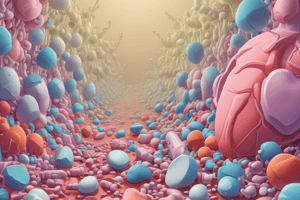Podcast
Questions and Answers
What is the drug classification of verapamil?
What is the drug classification of verapamil?
- ACE inhibitor
- Diuretic
- Beta blocker
- Calcium channel blocker (correct)
What is the mechanism of action of verapamil?
What is the mechanism of action of verapamil?
Lowers blood pressure by blocking calcium channels - results in vasodilation
Which of the following are adverse effects of verapamil? (Select all that apply)
Which of the following are adverse effects of verapamil? (Select all that apply)
- Reflux tachycardia (correct)
- Hypotension
- Increased anginal pain (correct)
- Headache (correct)
What should not be used with verapamil?
What should not be used with verapamil?
Who should avoid using verapamil?
Who should avoid using verapamil?
What adverse effect should the nurse monitor for when giving a verapamil IV bolus?
What adverse effect should the nurse monitor for when giving a verapamil IV bolus?
For which adverse effect should the nurse monitor when administering verapamil for cardiac dysrhythmias?
For which adverse effect should the nurse monitor when administering verapamil for cardiac dysrhythmias?
Flashcards are hidden until you start studying
Study Notes
Verapamil Overview
- Classified as a calcium channel blocker, verapamil is primarily used to treat hypertension, cardiac dysrhythmias, and angina pectoris.
Mechanism of Action
- Blocks calcium channels to lower blood pressure, resulting in vasodilation and overall cardiovascular improvement.
Adverse Effects
- Common side effects include:
- Reflux tachycardia
- Increased anginal pain in patients with existing angina
- Headache
- Lightheadedness and dizziness
- Facial flushing
- Peripheral edema
- Arrhythmias
- Gingival hyperplasia
Food and Drug Interactions
- Concomitant use with grapefruit, St John's wort, phenobarbital, phenytoin, rifabutin, and rifampin is strongly discouraged due to potential interactions.
Contraindications
- Not recommended for use in:
- Children
- Individuals with systolic blood pressure under 90 mm Hg
Nursing Considerations
- When administering verapamil IV bolus for cardiac dysrhythmias, monitor for hypotension as a significant adverse effect.
- Constant monitoring of blood pressure and pulse is essential prior to and during the administration of the drug.
Key Points for Administration
- Verapamil controls supraventricular tachyarrhythmias, acts as a coronary vasodilator, and serves as an antianginal agent.
Studying That Suits You
Use AI to generate personalized quizzes and flashcards to suit your learning preferences.



